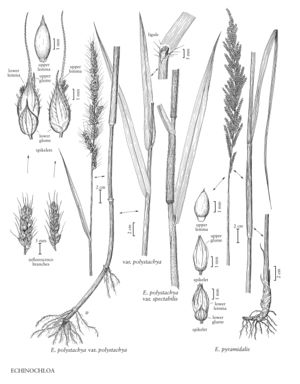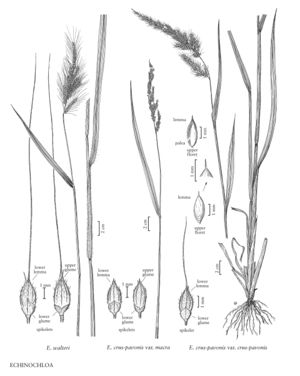Echinochloa
Plants annual or perennial; with or without rhizomes. Culms 10-460 cm, prostrate, decumbent or erect, distal portions sometimes floating, sometimes rooting at the lower nodes; nodes usually glabrous; internodes hollow or solid. Sheaths open, compressed; auricles absent; ligules usually absent but, if present, of hairs; blades linear to linear-lanceolate, usually more than 10 times longer than wide, flat, with a prominent midrib. Inflorescences terminal, panicles of simple or compound spikelike branches attached to elongate rachises, axes not terminating in a bristle, spikelets subsessile, densely packed on the angular branches; disarticulation below the glumes (cultivated taxa not or tardily disarticulating). Spikelets planoconvex, with 2 (3) florets; lower florets sterile or staminate; upper florets bisexual, dorsally compressed. Glumes membranous; lower glumes usually 1/4 - 2/5 as long as the spikelets (varying to more than 1/2 as long), unawned to minutely awn-tipped; upper glumes unawned or shortly awned; lower lemmas similar to the upper glumes in length and texture, unawned or awned, awns to 60 mm; lower paleas vestigial to well-developed; upper lemmas coriaceous, dorsally rounded, mostly smooth, apices short or elongate, firm or membranous, unawned; upper paleas free from the lemmas at the apices; lodicules absent or minute; anthers 3. Caryopses ellipsoid, broadly ovoid or spheroid; embryos usually 0.7-0.9 times as long as the caryopses. x = 9.
Distribution
Conn., N.J., N.Y., Wash., Va., W.Va., Del., D.C, Wis., Fla., Pacific Islands (Hawaii), Md., Mass., Maine, N.H., R.I., Vt., Wyo., N.Mex., Tex., La., N.C., N.Dak., Nebr., Idaho, Tenn., S.C., Pa., Utah, Virgin Islands, Nev., Colo., Ga., Puerto Rico, Calif., Ohio, Ala., Ark., Iowa, Kans., Okla., S.Dak., Ill., Ind., Ariz., Mich., Miss., Oreg., Alta., B.C., Man., N.B., Nfld. and Labr. (Labr.), N.S., Ont., P.E.I., Que., Sask., Mo., Minn., Mont., Ky.
Discussion
Echinochloa is a tropical to warm-temperate genus of 40-50 species that are usually associated with wet or damp places. Many of the species are difficult to distinguish because they tend to intergrade. Some of the characters traditionally used for distinguishing taxa, e.g., awn length, are affected by the amount of moisture available; others reflect selection by cultivation, e.g., non-disarticulation in grain taxa, mimicry of rice as weeds of rice fields. There are 13 species in the Flora region: five native and one possibly native, four established, two grown as commercial crops, and one in research.
In North America, the most abundant species appears to be the introduced, weedy Echinochloa crus-galli, which closely resembles the native E. muricata. The confusion between the two species has caused them to be treated as the same species. This confusion is probably reflected in the mapping of both E. crus-galli and E. muricata. Echinochloa frumentacea and E. esculenta are grown for grain in India and in China and Japan, respectively, but not in North America. Echinochloa oryzoides and E. oryzicola are weeds whose success and distribution reflects their adaptation to the periodic inundations of commercial rice fields.
Cytogenetic data suggest that Echinochloa frumentacea and E. esculenta are domesticated derivatives of E. crus-galli and E. colona, respectively (Yabuno 1962) and that E. oryzoides is very closely related to E. crus-galli (Yabuno 1984). Yabuno (1966) suggested that E. crus-galli is an allohexaploid produced by natural hybridization between the tetraploid E. oryzicola with a not-yet-discovered diploid species of Echinochloa and subsequent chromosome doubling. Studies using seed protein electrophoresis and isozyme analyses (Kim et al. 1989; Gonzalez-Andres et al. 1996; Asins et al. 1999), and molecular studies involving RAPD markers and DNA sequences (Hilu 1994; Roy et al. 2000) or PCR-RFLP techniques (Yasuda et al. 2001), will help in clarifying the phylogenetic problems in Echinochloa, providing that proper attention is paid to the morphological characterization of the plant materials used and that voucher specimens are preserved.
Selected References
Lower Taxa
Key
| 1 | Ligules of stiff hairs present on the lower leaves; lower florets staminate; plants perennial. | > 2 |
| 2 | Plants without scaly rhizomes, sometimes rooting at the lower nodes; lower lemmas usually awned, sometimes merely apiculate; known outside of experimental plantings | Echinochloa polystachya |
| 2 | Plants with short, scaly rhizomes; lower lemmas unawned, sometimes long-cuspidate; in the Flora region, known only from experimental plantings | Echinochloa pyramidalis |
| 1 | Ligules almost always absent from all leaves, the ligule region sometimes pubescent; lower florets sterile or staminate; plants usually annual, sometimes short-lived perennials. | > 2 |
| 3 | Lower lemmas usually unawned; spikelets, particularly those near the base of the panicles, not disarticulating at maturity; upper lemmas wider and longer than the upper glumes at maturity and, hence, exposed at maturity. | > 4 |
| 4 | Spikelets always green and pale at maturity, their apices usually obtuse, varying to acute; rachis nodes not or only sparsely hispid with papillose-based hairs; caryopses whitish | Echinochloa frumentacea |
| 4 | Spikelets purplish to blackish-brown at maturity, their apices obuse to shortly acute; rachis nodes densely hispid with papillose-based hairs; caryopses brownish | Echinochloa esculenta |
| 3 | Lower lemmas often awned; spikelets disarticulating at maturity; upper lemmas not or scarcely exceeding the upper glumes in length and width at maturity. | > 4 |
| 5 | Plants essentially obligate weeds of rice, growing in the fields; culms erect, densely tufted; spikelets 3.7-7 mm long; plants resembling rice in their vegetative growth. | > 6 |
| 6 | Panicles horizontal or drooping at maturity; spikelets broadly ovate to ovate; lower lemmas usually awned; caryopses 1.9-3 mm long, the embryos 70-85% as long as the caryopses | Echinochloa oryzoides |
| 6 | Panicles erect to slightly drooping; spikelets ovate-elliptical; lower lemmas awned or not; caryopses 1.7-2.6 mm long, the embryos 89-98% as long as the caryopses | Echinochloa oryzicola |
| 5 | Plants not obligate weeds of rice, found in summer crops and wet places, and often in rice fields; culms sprawling, decumbent or erect; spikelets 2-5 mm long; plants occasionally resembling rice vegetatively but, if so, the spikelets less than 3 mm long. | > 6 |
| 7 | Lower florets staminate; anthers of the upper florets 1.2-1.7 mm long | Echinochloa paludigena |
| 7 | Lower florets sterile; anthers of the upper florets 0.5-1.2 mm long. | > 8 |
| 8 | Panicle branches 0.7-2(4) cm long, without secondary branches; spikelets 2-3 mm long, unawned | Echinochloa colona |
| 8 | Panicle branches 1-14 cm long, usually rebranched, the secondary branches often short and inconspicuous; spikelets 2.5-5 mm long, awned or unawned. | > 9 |
| 9 | Upper lemmas broadly ovate to elliptical, if elliptical, each with a line of minute (need 25x magnification) hairs across the base of the early-withering tips. | > 10 |
| 10 | Upper lemmas with rounded or broadly acute coriaceous apices that pass abruptly into a membranous tip, a line of minute hairs present at the base of the tip | Echinochloa crus-galli |
| 10 | Upper lemmas with acute or acuminate coriaceous apices that extend into the membranous tip, without hairs at the base of the tip | Echinochloa muricata |
| 9 | Upper lemmas narrowly ovate to elliptical, never with a line of minute hairs across the base of the early-withering, membranous tips. | > 10 |
| 11 | Spikelets 2.5-3.4 mm long; lower lemmas unawned or with awns 3-10(15) mm long, curved | Echinochloa crus-pavonis |
| 11 | Spikelets 3-5 mm long; lower lemmas usually with awns 8-25 mm long, typically straight. | > 12 |
| 12 | Blades 10-35(60) mm wide; sheaths usually hispid and the margins ciliate with prominent papillose-based hairs, sometimes the sheaths only papillose; lower lemmas awned, the awns 8-25(60) mm long; common in the eastern portion of the Flora region | Echinochloa walteri |
| 12 | Blades 5-10 mm wide; sheaths glabrous or with papillose-based hairs; lower lemmas unawned or awned, the awns 8-16(50) mm long; in the Flora region, known only from southern Arizona | Echinochloa oplismenoides |
"decumbent" is not a number.


